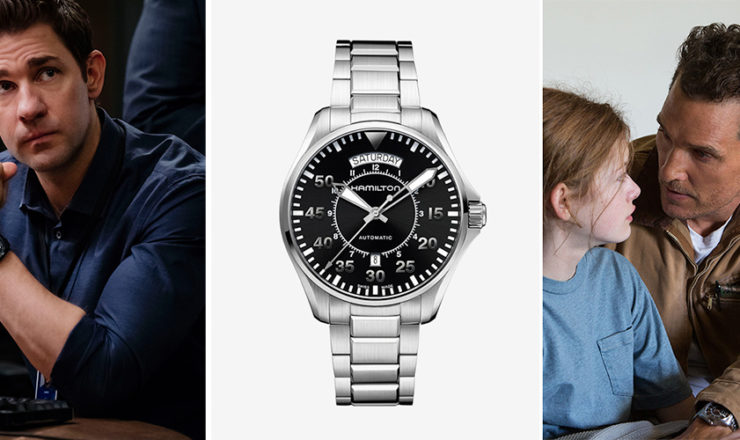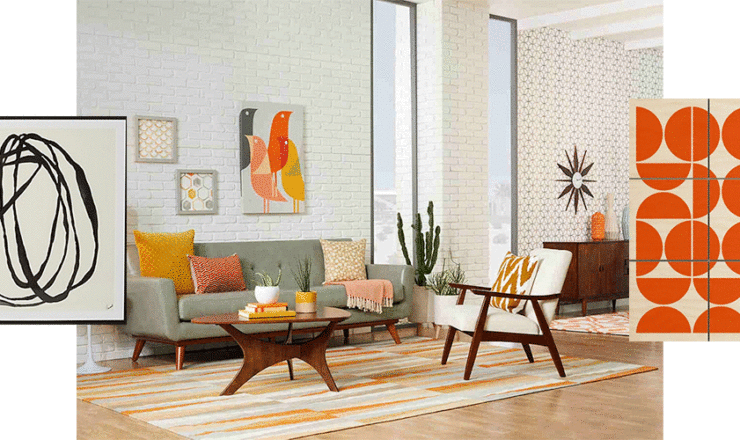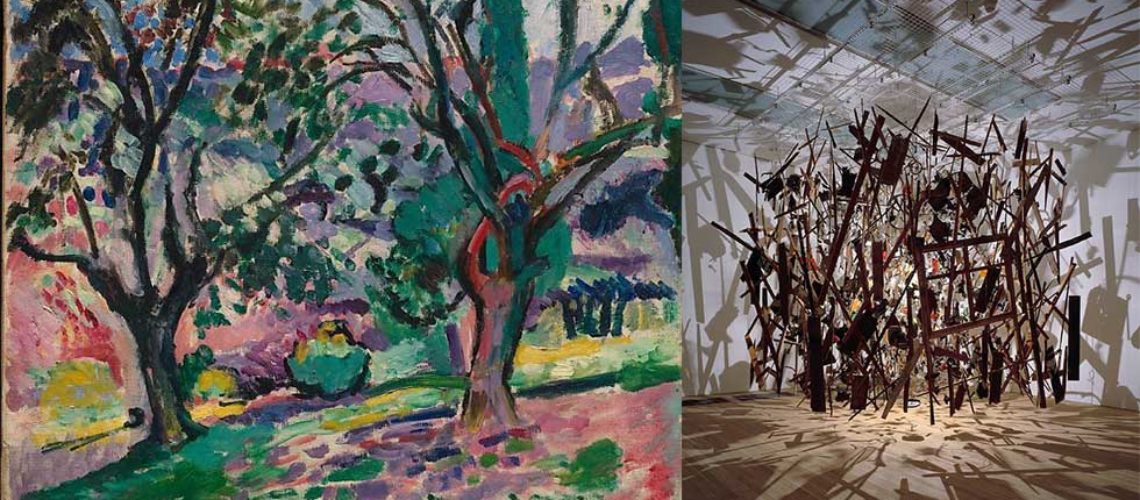
Types of Art Styles & Movements Throughout History
Last Updated on: 8th August 2024, 12:54 am
History has provided a mass of adroit art influenced by differing philosophies, traditions, cultures, principles and ideologies.
These artworks produced over the years can be seen and felt as absorbing, acclaimed, awe-inspiring and aesthetically pleasing with a number of them being accomplished, distinctive and elevating in abstract form.
In spite of the fact that classifications can be seen as remissive, different artistic styles, visuals and tendencies can be grouped into collectives called art movements.
The classification of art with its various respective movements can be an academic discipline in its own right.
Though initially it may seem overly complex or polarizing, acquainting yourself with the top art styles and movements throughout history will equip you with a better understanding and appreciation of art as a whole while removing any apprehensions in art such as the notion that art can only be understood by those that have dedicated their lives to studying it or by the supposedly rare and gifted bunch.
In essence, Art is merely one way to communicate without a language barrier.
Essential Art Movements and Styles
The following is an alphabetically arranged list of the top art styles and movements throughout history and a brief discussion of each:
- Abstract Expressionism
- Art Deco
- Art Nouveau
- Avant-garde
- Baroque
- Bauhaus
- Classicism
- Conceptual Art
- Constructivism
- Cubism
- Dada / Dadaism
- Expressionism
- Fauvism
- Futurism
- Impressionism
- Installation Art
- Land Art
- Minimalism
- Neo Impressionism
- Neoclassicism
- Performance Art
- Pop Art
- Post Impressionism
- Precisionism
- Rococo
- Surrealism
- Suprematism
- Symbolism
Abstract Expressionism
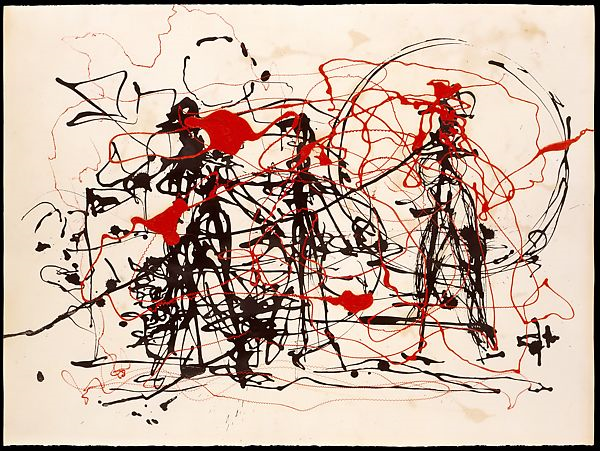
“Untitled” by Jackson Pollock ca. 1948 – 1949
IMAGE SOURCE: The Heilbrunn Timeline of Art History (Pollock, n.d.)
In the 1940s a movement also known as The New York School was established to showcase abstract art intended to reflect the individual psyches (Paul, 2004) through ‘action painted’ unplanned brush strokes that would sweep across or drip paint in unpremeditated patterns on large canvases.
Though the Abstract Expressionism movement incorporated other types of media in addition to large painted canvases such as sculptures and nontraditional painting materials paired with new techniques of painting on canvas that was intentionally not stretched, not primed or even both.
Abstract Expressionism formed a distinctly American style of art. (MoMA Learning, n.d.)
Art Deco
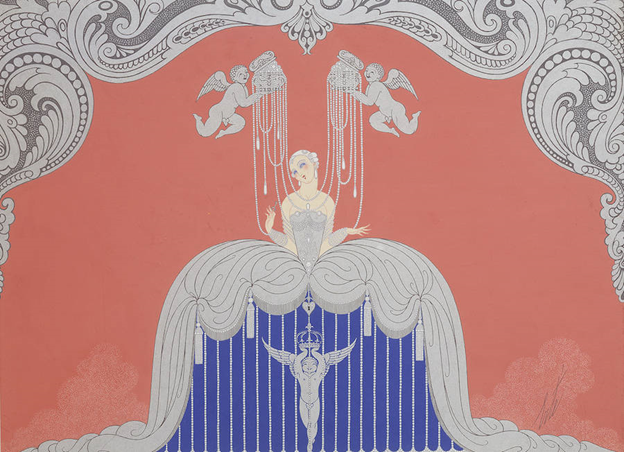
“Costume pour Le Triomphe de la femme” by Roman Petrovich Tyrtov (pseudonym ‘ Erté’) 1926
IMAGE SOURCE: The State Hermitage Museum (Tyrtov)
Art Deco – referred to at times as Deco and is seen as a response contra to Art Nouveau that it succeeded (Tate, n.d.) – is a design style emerging in the 1920s and 1930s characterized by geometrically symmetrical shapes that were streamlined and frequently straightforward.
Art Deco intended to be pleasing to the eye without much intellectual thought or debate behind it (The Art Story, n.d.).
Although the Deco art style was illustrated in various artworks from drawings, sketches, to different paintings in mediums like gouache, it is also considered an architectural style and is seen throughout various visuals such as construction, furniture, sculpture and decorative arts that can also be seen in interior design.
(Pennsylvania Historical and Museum Commission, n.d.)
Art Nouveau
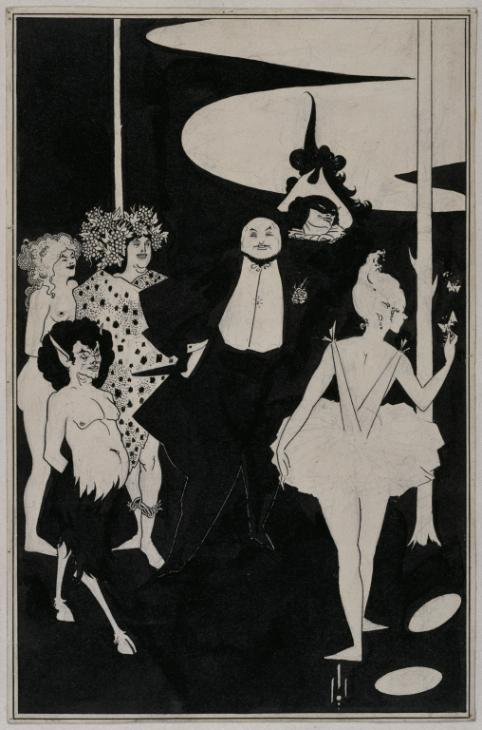
Design for the Frontispiece to John Davidson’s Plays by Aubrey Beardsley 1894
IMAGE SOURCE: The Tate Exhibit (Beardsley)
Booming in the 1890s, Art Nouveau went by the names of Glasgow Style, Jugendstil (Germany), Stile Floreale (Italy), Sezessionstil (Austria) and was influenced by the lines and geometric shapes of stems and plant blossoms creating decorative and graphic art that would display elegant united forms that flowed naturally.
Linearly laid out contours took priority over colors which were exhibited in muted earthy tones of black, gray, brown, yellow and blue. (The Art Story, n.d.)
Like Art Deco, the Art Nouveau style was represented in various visual arts inclusive of architecture, furniture, sculpture and decorative pieces, often having the interior of Art Nouveau buildings as intricate as its exterior (Stamp, 2016)
Avant-garde
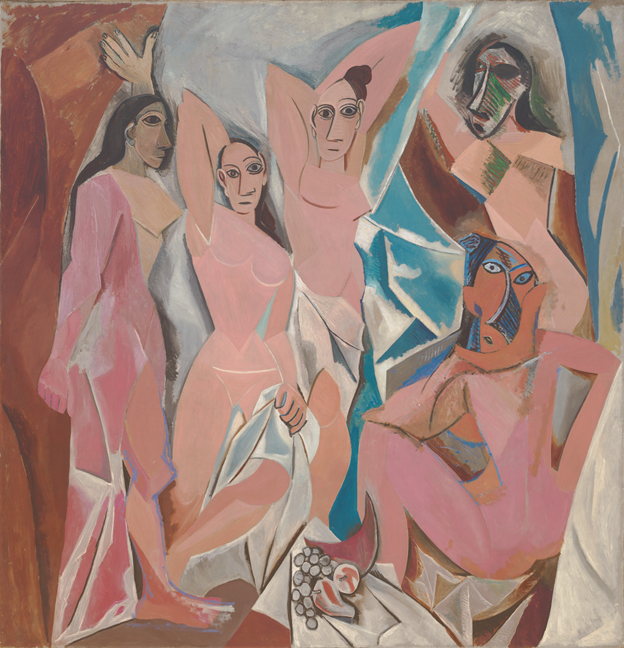
Les Demoiselles d’Avignon by Pablo Picasso June to July 1907
IMAGE SOURCE: The Museum of Modern Art MoMA (Picasso, Les Demoiselles d’Avignon)
Considered as emerging in the 1850s, Avant-garde is a French term for the body of soldiers positioned to go ahead of the rest of the army in preparation for the main body of the army, also known as vanguard or advanced guard in English.
Avant-garde’s main idea is to have art evaluated principally on the artist’s concepts and perceptions (Tate, n.d.)
In some avant-garde movements, the art produced was an image of a yearning to break free from social norms and mainstream aesthetic conventions with associations to radical social or political change and agenda (The Art Story, n.d.)
Baroque
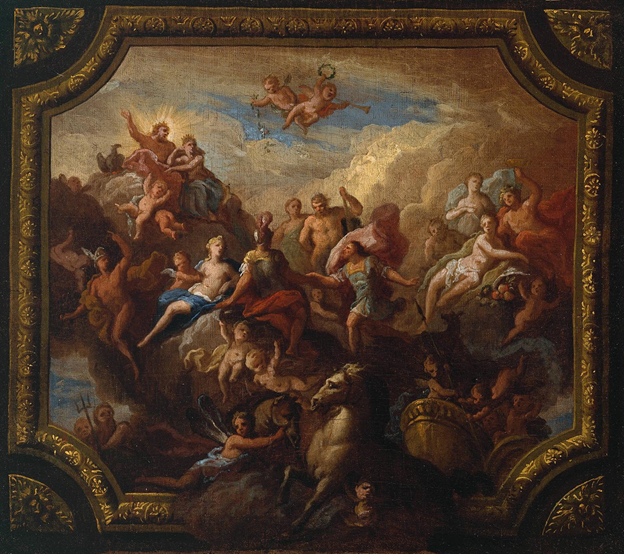
The Apotheosis of Romulus: Sketch for a Ceiling Decoration, Possibly for Hewell Grange, Worcestershire by Sir James Thornhill c.1710
IMAGE SOURCE: The Tate Exhibit (Thornhill)
Baroque is an art movement that peaked in Rome at about 1630 – 1680 and is a term that stands for ‘irregularly shaped pearl’ originating from the Portuguese word ‘barocco’. Baroque is an art style that is relevant to the Catholic Counter Reformation though it can be seen in non-religious subjects portraying mythical creatures, still life or portraits.
Baroque is marked by a realism that makes the viewer feel as if they were there to witness the actual events of the paintings unfold. (Tate, n.d.)
A central component of Baroque is the use of light and dark colors to generate dramatic tension tied to a direct emotional appeal.
Baroque architecture is pronounced by opulence and an inclination for the highly ornamented. (The Art Story, n.d.)
Bauhaus
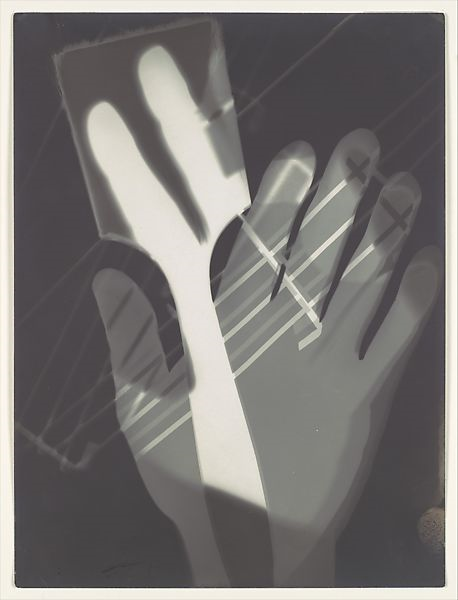
Fotogramm by László Moholy-Nagy 1926
IMAGE SOURCE: The Met Museum (Moholy-Nagy)
Established in 1919 by Walter Gropius in Germany, the Bauhaus teaching methodology took an innovative approach into arts where traditional student-teacher learnings were discarded for artistic community learning that concentrated on the creation of functionality and beauty.
Bauhaus targeted to give interior design, architecture, performing arts and applied arts as much importance as fine arts. (Tate, n.d.) Bauhaus became a new method of living, giving way to Gropius’ vision of a “utopian craft guild combining architecture, sculpture, and painting into a single creative expression.” (Winton, 2007)
Classicism
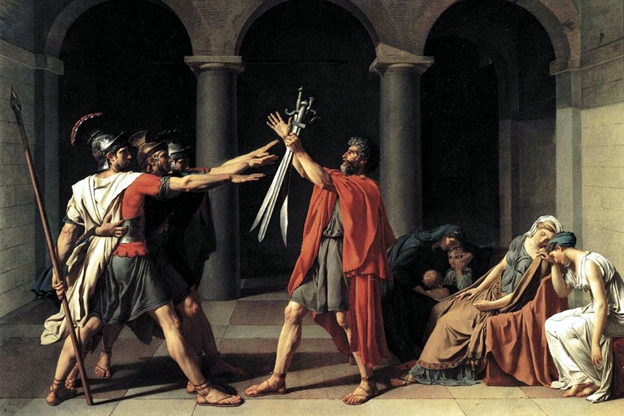
Oath of the Horatii by Jacques-Louis David 1784
IMAGE SOURCE: HiSoUR (David)
Classicism is reminiscent of ancient art of Greek and Rome, first emerging during the Italian Renaissance after the fall of Byzantium.
(Art History, n.d.) Works of Classicism embodied ideals that inspire and served as the standards for nobility, soundness of logic, power, and verity of which beauty is the result thereof. (HiSoUR, n.d.) This art style focuses on accord, moderation, refinement and deference (Tate, n.d.) to the compelling models of imitation that Classicism would depict regarding the ideal human experience.
Conceptual Art
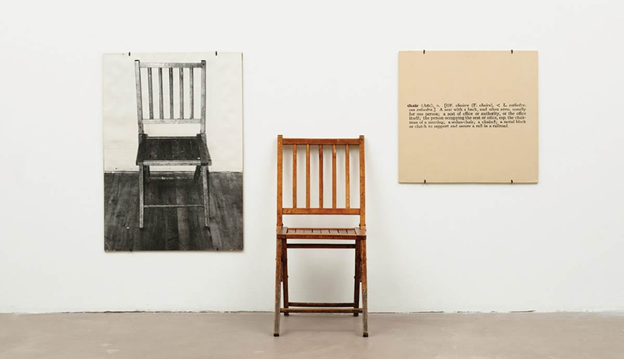
One and Three Chairs by Joseph Kosuth 1965
IMAGE SOURCE: The Museum of Modern Art MoMA (Kosuth)
Conceptualism, more commonly known as Conceptual Art, arose as a movement in the 1960s and is used to refer to art made in the mid-1960s until the mid-1970s.
This movement places more importance on the vision, concept or idea behind the art rather than the actual physical product.
(Tate, n.d.) Artist Sol Lewitt coined the term to describe this new art classification in his 1967 essay entitled Paragraphs on Conceptual Art where he wrote “The idea itself, even if it is not made visual, is as much of a work of art as any finished product.” (MoMA Learning, n.d.)
Constructivism
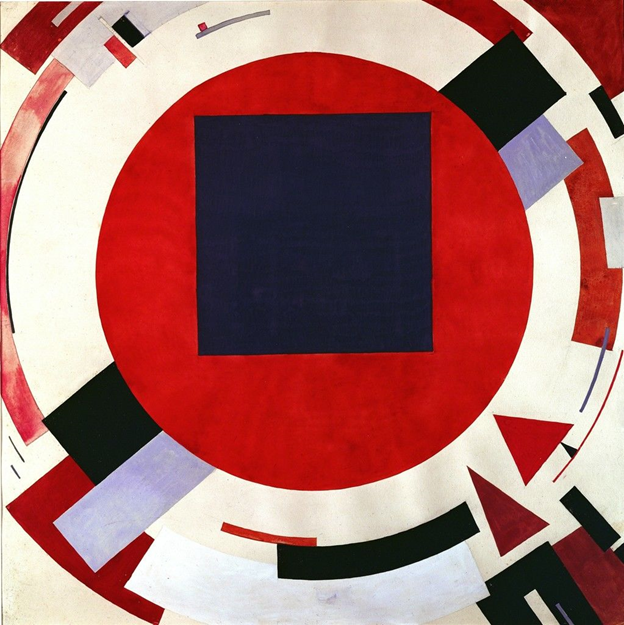
Proun (Project for Progress) by El Lissitzky 1924
IMAGE SOURCE: Stedelijk Van Abbemuseum, Eindhoven (Lissitzky)
Constructivism as a branch of abstract art was industrialized by the Russian avant-garde in 1915 – 1940 aimed at the ideal that art should be directed towards being used as a tool for sociopolitical purposes such as the Communist Revolution.
Constructivists did not believe in the idea of “art for art’s sake” with Aleksei Gan, an avant-garde artist who was a central figure in developing Constructivism, declaring that “We [constructivists] declare uncompromising war on art!” (Artland, n.d.) Constructivism is primarily geometric with a penchant for accuracy in composition done through the aid of mathematics and measuring tools if needed.
Cubism
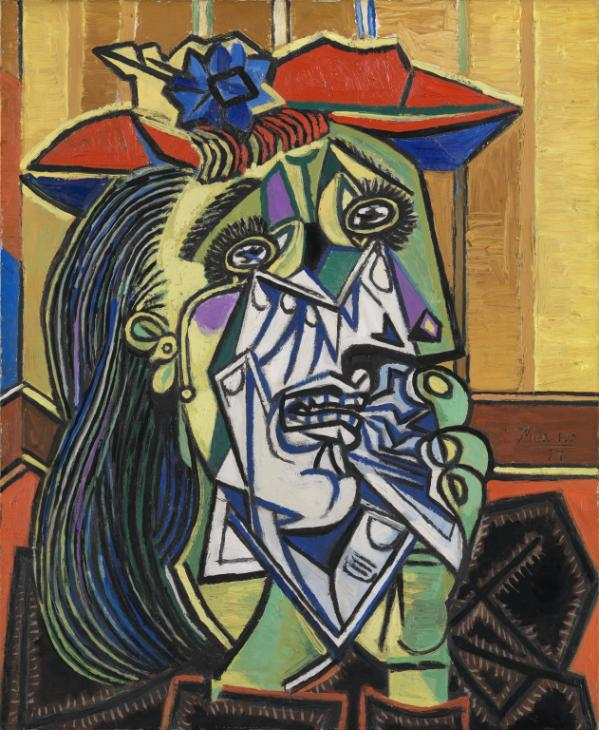
Weeping Woman (original title “Femme en pleurs”) by Pablo Picasso 1937
IMAGE SOURCE: The Tate Exhibit (Picasso, Weeping Woman)
Invented by the artists Pablo Picasso and Georges Braque in approximately 1907 – 1908, Cubism presented the differing perspectives of traditional subjects such as objects or figures in one canvas leading to an abstract, fragmented art style whose visual language consists of translating objects and figures into apparent geometrical planes.
(Tate, n.d.) As described by the refugee artist named Jacques Lipchitz, “Cubism is like standing at a certain point on a mountain and looking around.
If you go higher, things will look different; if you go lower, again, they will look different. It is a point of view.” (Lipchitz)
Dada / Dadaism
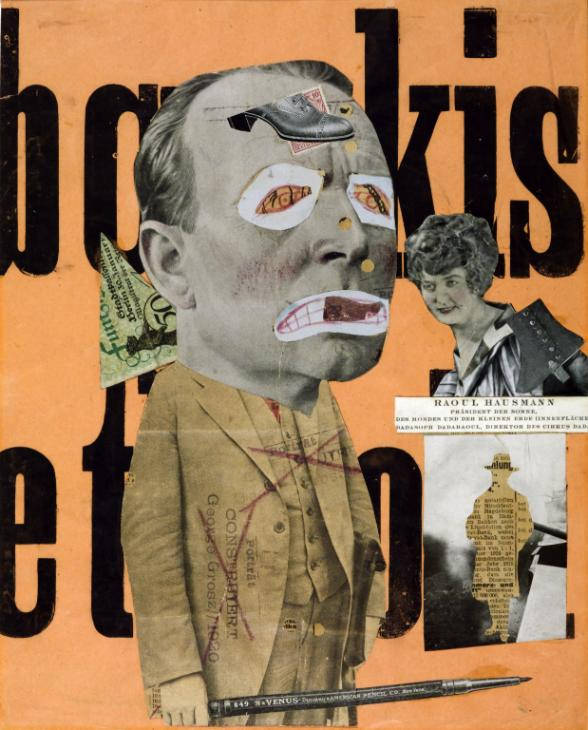
The Art Critic by Raoul Hausmann 1919 – 1920
IMAGE SOURCE: The Tate Exhibit (Hausmann)
Emerging during the First World War (1914 – 1918) in Zurich as an opposing artistic response to the habitually suppressive and authoritarian societal norms and practices, Dada or Dadaism sought to question the exploitive fundamentals of war and established conventions of logic or order that make up the degrading social structures.
(Tate, n.d.) Dada artists embodied a protest movement with the aesthetics of the art produced only secondary to the beliefs being visually communicated.
Hugo Ball, a poet and writer who founded Dada, wrote that “For us, art is not an end in itself, but it is an opportunity for the true perception and criticism of the times we live in.” (MoMA Learning, n.d.)
Expressionism
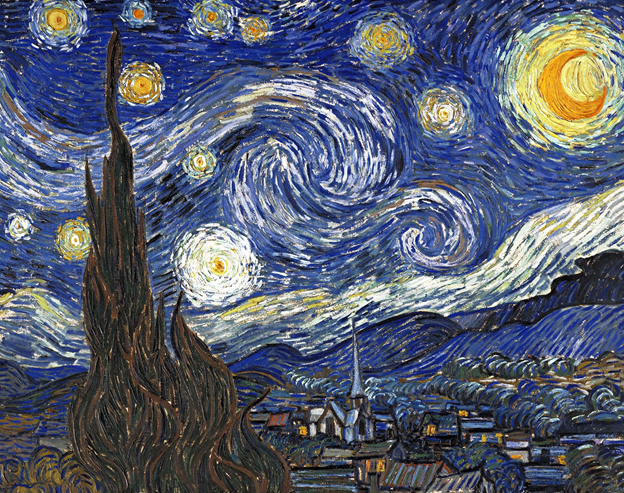
The Starry Night by Vincent van Gogh 1889
IMAGE SOURCE: History Archive (Gogh, The Starry Night)
Emerging prominently in Germany and Austria between 1905 and 1920, Expressionism was a way for artists to relay their feelings, ideas and emotional experiences first and foremost without much regard to physical reality by portraying the world as it felt and not as it looks during a time full of apprehension, fears, distress and worries amidst the devastation caused by World War I (MoMA Learning, n.d.) Expressionism favors exaggerated execution of color through distorted, swaying or swirling brush strokes intended to invoke an emotional response to the anxieties of the modern world. (The Art Story, n.d.)
Fauvism
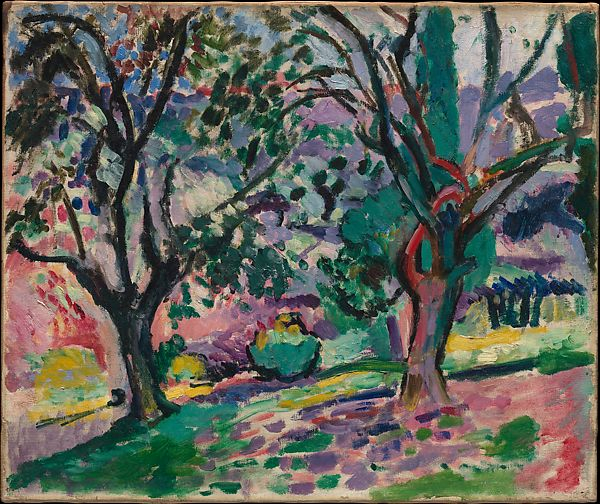
Olive Trees at Collioure by Henri Matisse 1906
IMAGE SOURCE: The Met Museum (Matisse)
The critic Louis Vauxcelles coined the term Fauvism from the French words les fauves meaning ‘the wild beasts’ in response to seeing the art of Henri Matisse and Andre Derain composed of bold, vibrant colors that were not natural to the subjects so simplified it began appearing abstract as they were painted with unpremeditated dabs of loose paint often applied straight out of the tube. (Tate, n.d.)
Fauvism had a radical goal of making color independent from its traditionally descriptive and representative purpose to make way for it to exist on the canvas as a sovereign element. These vivid colors would be used to define light and space. (The Art Story, n.d.)
Futurism
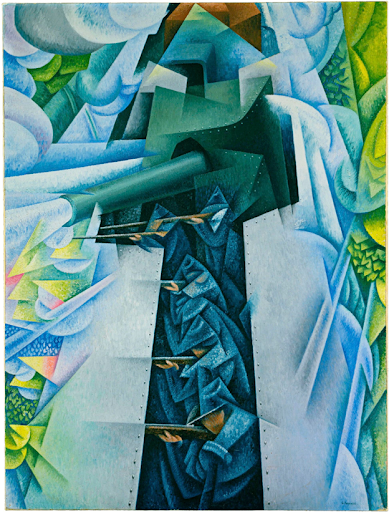
Armored Train in Action by Gino Severini 1915
IMAGE SOURCE: The New Yorker. Art Courtesy by The Museum of Modern art also known as MoMA (Severini)
Initiated in 1909 by the Italian poet Filippo Tommaso Marinette, Futurism aimed to capture the dynamics of the modern mechanical world and its velocity through abstract art and literature.
Futurism heavily condemns the culture of a repressive, tyrannical past. Instead, Futurists promoted the celebration of the modern industrial and technological world through art. (Tate, n.d.)
Futurism artworks depicted a key focus to movement, motion or being dynamic with a number of novel methods being established such as repetition, blurring and the use of lines of force. (The Art Story, n.d.)
Impressionism
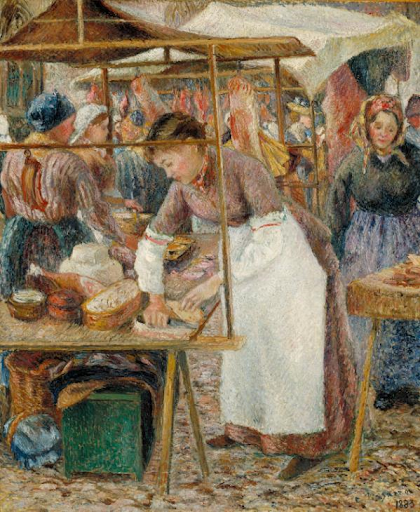
The Pork Butcher by Camille Pissaro 1883
IMAGE SOURCE: The Tate Exhibit (Pissaro)
Founded in 1874 by Claude Monet, Edgar Degas, Camille Pissarro, and Alfred Sisley among others (Samu, 2004), Impressionism is a movement that consisted of vivid colors painted on with brushstrokes that tended to be lighter, looser and less rigidly structured than other art styles (The Art Story, n.d.) Impressionism was more about capturing the ‘impressions’ of everyday life and movement as it happened in the eyes of the artist that produced the art.
Impressionism meant to reflect what was seen at the moment. (Tate, n.d.) It is at its core anti-academic and independent from annual exhibitions sponsored by the government known as Salons, choosing instead to exhibit art in venues other than established exhibitions.
Installation Art
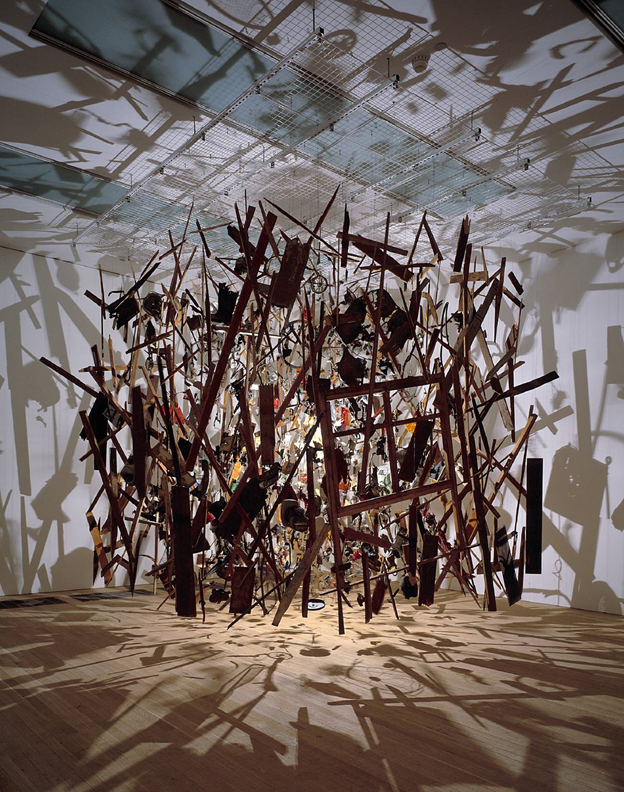
Cold Dark Matter: An Exploded View by Cornelia Parker 1991
IMAGE SOURCE: The Tate Exhibit (Parker)
Emerging in the late 1950s, Installation Art also known as ‘environments’ is a movement that made use of mixed media materials and constructions that were scaled to fit specifically on site to create artworks that needed to be walked through or around in order to be completely contemplated or in order to be fully engaged with the art.
Installation art was created to be an experience that was absolutely integrated instead of being a display of individually separated art pieces. (Tate, n.d.)
The Installation Art movement pushes against commodifying art by making artworks that are difficult to sell or collect and in so doing, the artworks made cannot be measured by the traditional mechanisms or criteria for determining its monetary value. (The Art Story, n.d.)
Land Art
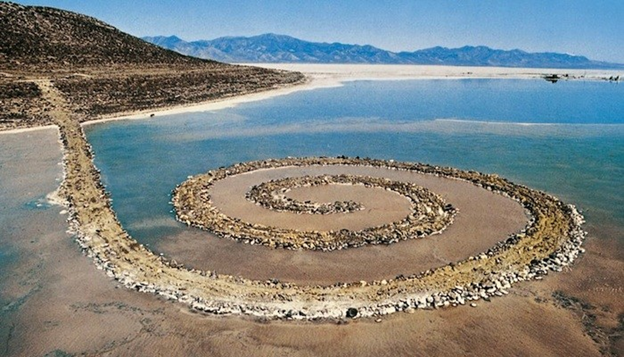
Spiral Jetty by Robert Smithson 1970
IMAGE SOURCE: Art Space (Smithson)
Arising in the 1960s and 1970s Land Art also known as Earth Art, Earthworks or Environmental Art (The Art Story, n.d.), is the composition of natural elements or materials such as soil, water, gravel, rocks, twigs, plants and trees into sculptures, structures or other landscaped based forms (Tate, n.d.) usually on a monumental scale though Land Art has also been made in galleries or by bringing landscape materials to make installations.
In a way, Land Art can be seen as a natural or organic version of Installation Art.
Minimalism
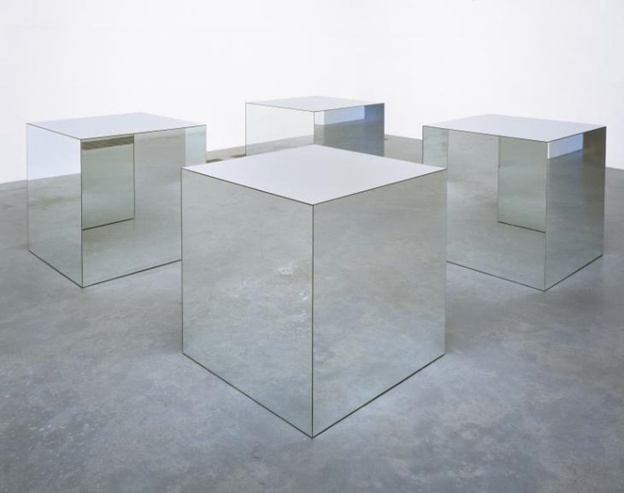
Untitled by Robert Morris 1965, reconstructed 1971
IMAGE SOURCE: The Tate Exhibit (Morris)
Emerging in the late 1950s, minimalism was developed as an extension of the abstract idea that art should not be an imitation, presentation or reflection but rather art should possess its own reality. (Tate, n.d.). Minimalism aimed to be art of its purest form, barren of depictive content that aimed to defy outdated designs of craftsmanship.
Minimalism renounced excessiveness in symbolism and emotional content in favor of prioritizing the corporeality of the artwork made usually from prefabricated industrial materials designed to be sleek, simple and often just geometric while doing away with the conventions of a normalized or widespread aesthetic appeal. (The Art Story, 2015)
Neo-Impressionism
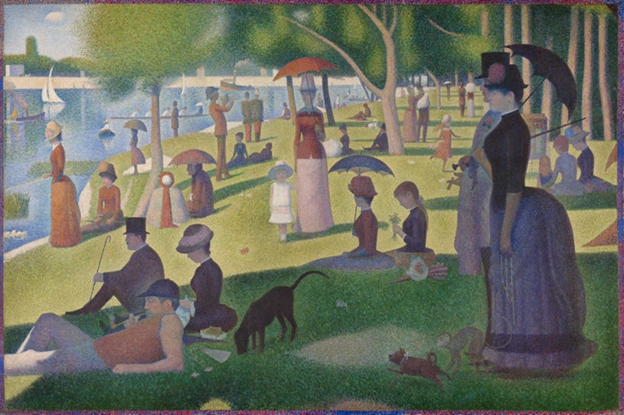
A Sunday Afternoon on the Island of La Grande Jatte by Georges Seurat 1884
IMAGE SOURCE: Art Institute Chicago (Seurat)
Emerging mainly in France from 1886 to 1906, an avant-garde art movement known as Neo-Impressionism led by Georges Seurat and Paul Signac was founded. (MoMA, n.d.)
Neo-impressionism renounced the extemporaneity and romanticism of Impressionism in inclination to a methodical divisionism commonly but erroneously called as pointillism that placed tiny dots of colors on the canvas which would mix and form images in the spectator’s eye. Neo-impressionism is based on optical color theories and the scientific studies of M-E Chevreul (Tate, n.d.)
Neoclassicism
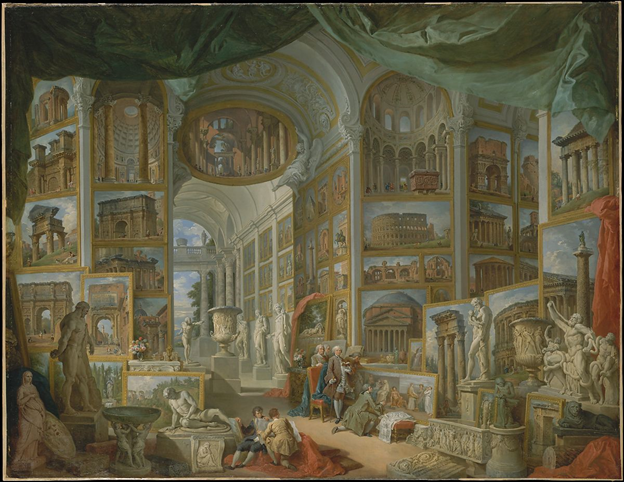
Ancient Rome by Giovanni Paolo Panini 1757
IMAGE SOURCE: The Met Museum (Panini, 1757)
Emerging around 1750 as an unadulterated form of Classism, (Tate, n.d.) Neoclassicism was a movement that was designed to retrieve the honors, splendors and magnificence of lost civilizations through visual arts (Gontar, 2003).
Neoclassicism is constructed on firsthand observation of historical and ancient Greek and Roman works that reigned Europe in painting, sculpture, decorative arts and architecture. (MoMA, n.d.)
Performance Art

Performance Still by Mona Hatoum 1985, 1995
IMAGE SOURCE: The Tate Exhibit (Hatoum, 1985)
Becoming a widespread term in the 1970s for the movement formerly known as ‘body art’, Performance or Performance Art is an unconventional way of creating art that deviated from the usual static perpetuity of painting, sculpture and other stationary visual arts. (Tate, n.d.)
Performance Art is showcased live or pre-recorded and was produced through the physical actions of artists, collaborators, performers or other contributors extemporaneously or rehearsed and planned. (The Art Story, n.d.)
Pop Art
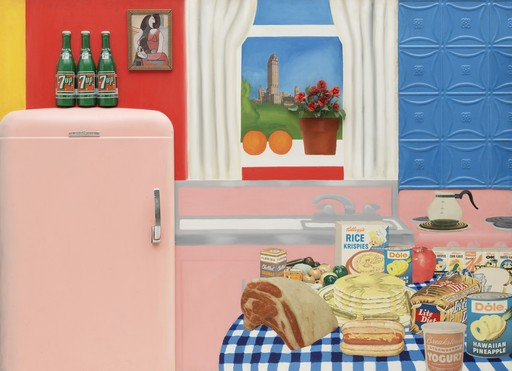
Still Life #30 by Tom Wesselmann. April 1963
IMAGE ART: The Museum of Modern Art (Wesselmann, 1963)
Emerging in the 1950s and booming in the 1960s Pop Art, primarily dominating America and Britain, consisted of art that drew influence from commercial and popular culture as opposed to the Greco-Roman, philosophical, or conceptual inspirations of fine art (Tate, n.d.)
Pop Art emphasized the kitschy and common elements of everyday life in forms of large-scale facsimiles, silkscreens that are mechanically reproduced and soft sculptures that transformed day-to-day items into a magnified scale among others. (The Art Story, 2016)
Post-Impressionism
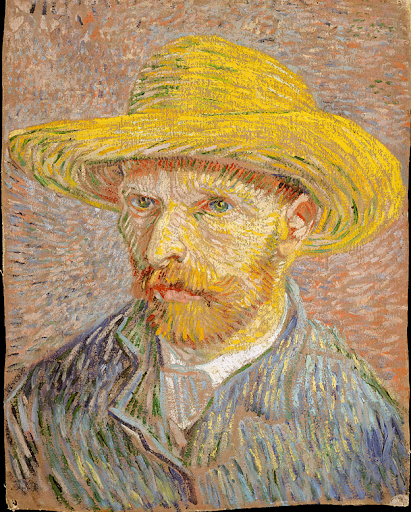
Self Portrait with a Straw Hat (obverse: The Potato Peeler) by Vincent van Gogh 1887\
IMAGE SOURCE: The Met Museum (Gogh, Self-Portrait with a Straw Hat (obverse: The Potato Peeler), 1887)
First coined in 1910 by British art critic and painter Roger Fry, Post Impressionism was an extension of Impressionism developed in four particularly different directions by the artists Paul Cezanne, Paul Gauguin, Georges Seurat and Vincent van Gogh. (Tate, n.d.)
Post Impressionism sought to rebel against the true-to-life depiction of light and color limitations of Impressionism through a range of personal styles that supplied the emotional, operational, symbolic and spiritual elements that Post Impressionist artists felt Impressionism lacked. (Art Factory, n.d.)
Precisionism
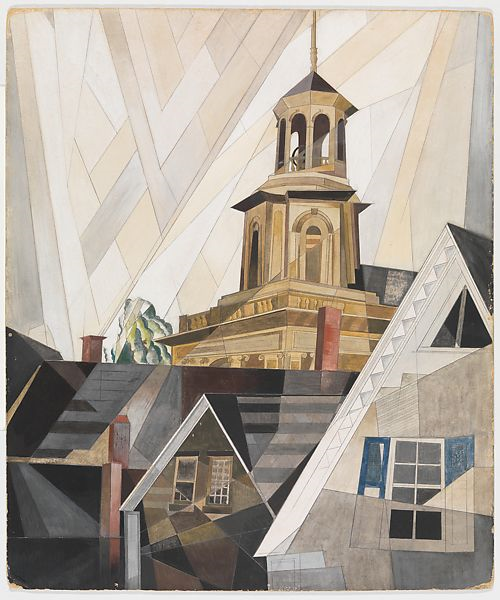
After Sir Christopher Wren by Charles Demuth 1920
IMAGE SOURCE: The Met Museum (Demuth, 1920)
Precisionists marked the dawn of America’s innovative industrial and scientific age through a visual translation of nonchalantly disconnected semi-abstractions that showed a united partiality to geometric forms that were further simplified and akin to the likes of Cubism and Futurism. (The Art Story, 2021).
Driven by the desire to bring structure back to art and celebrate the new American landscape of bridges, factories and skyscrapers, Precisionism experimented with an exceedingly detailed and meticulous approach to technique and form, often reducing compositions to simple shapes and primary geometrical structures with minimal details, clear outlines and handling of surfaces done smoothly. (Murphy, 2007)
Rococo
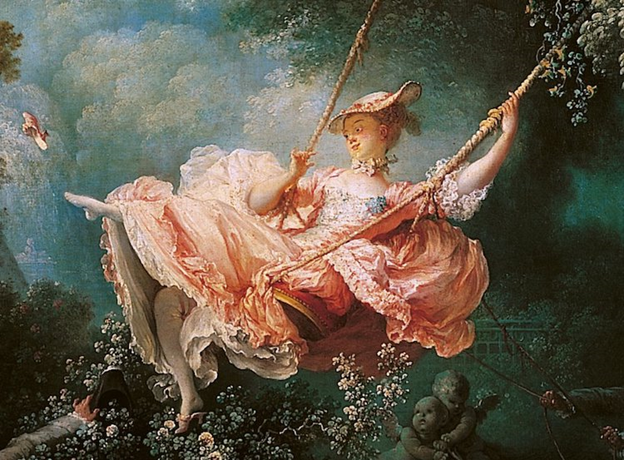
The Swing by Jean Honore Fragonard ca. 1766 – 1769
IMAGE SOURCE: My Modern Met (Fragonard, 1766)
Originating in France in the early 1700s (The Art Story, 2018), the term Rococo means “shell” or rock work created from the forms of corals and sea shells derived from the French word rocaille (Tate, n.d.).
Rococo is occasionally referred to as the ‘feminine’ version of the Baroque art movement as it depicts aristocracy through gentle, often pastel colors that display tall and slender subjects who are also sophisticated, delicate, refined and exquisite even down to the manner of their clothing, activities and surroundings. (Sullivan, n.d.)
Rococo decorative art had an inclination towards embellishment and intricate detailing.
Surrealism
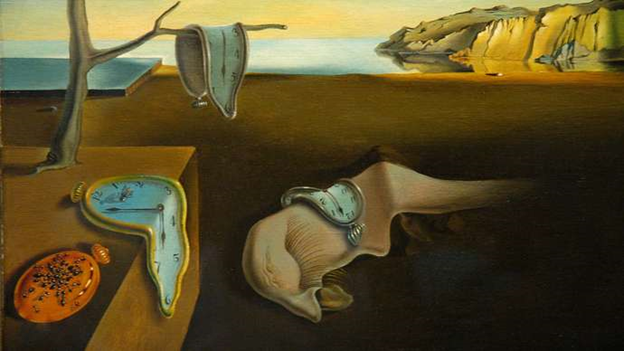
The Persistence of Memory by Salvador Dali 1931 | IMAGE SOURCE: Britannica (Dali, 1931)
An art movement initiated in 1924 through World War II by the poet André Breton, Surrealism sought to break away from the rules of modern society that were considered oppressive by creating art that disregarded the rationality of thoughts through tapping into the “superior reality” of the subconscious mind. (MoMA Learning, n.d.)
Surrealism favored the worth of dreams and the unconscious, finding beauty in the unforeseen and the eerie or uncanny.
Surrealism artworks championed the poetic, irrational and revolutionary through liberating thoughts, language and human experience from the boundaries of rationalism by portraying psychological tensions that were hidden or trapped in a dream world like state. (Tate, n.d.)
Suprematism
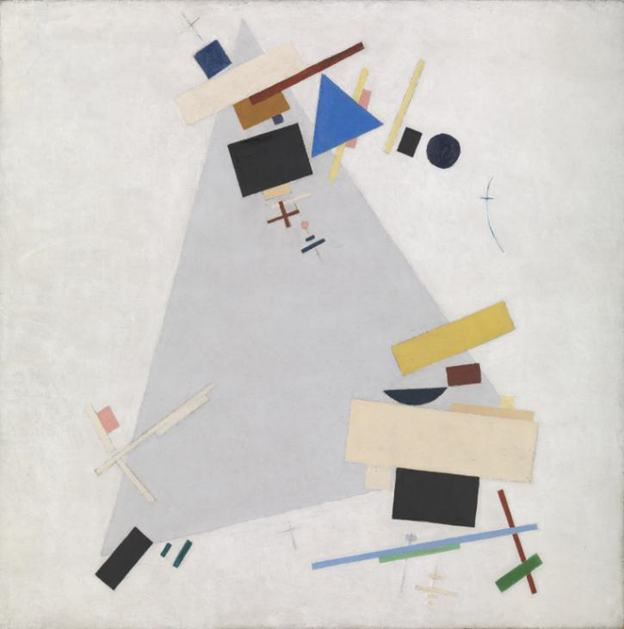
Dynamic Suprematism by Kazimir Malevich 1915 or 1916 | IMAGE SOURCE: The Tate Exhibit (Malevich, 1915 or 1916)
Named and founded in 1913 by the Russian artist Kazimir Malevich, Suprematism is characterized by being closely linked with the Revolution, using limited color ranges in abstract compositions that would encapsulate simplified geometric shapes like squares, circles, triangles, rectangles and lines. (Tate, n.d.)
The principal belief behind Suprematism is that it would be superior to all other representational arts of the past as it would lead to the “supremacy of pure feeling or perception in the pictorial arts.”
Malevich was captivated by the quest of discovering art in its purest form, grounded on the belief that there were faint yet distinct links between words or signs and the objects of which they denote. (The Art Story, n.d.)
Symbolism
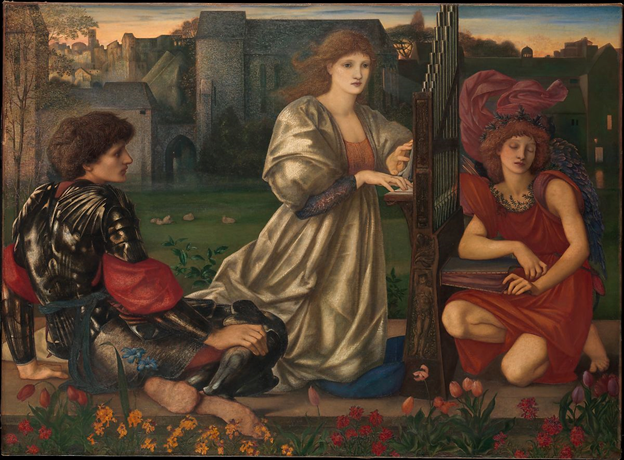
The Love Song by Sir Edward Burne Jones 1868 – 1877 | IMAGE SOURCE: The Met Museum (Jones, 1868 – 1877)
Originally developed as a French literary movement in the 1880s, Symbolism is a term coined in 1886 by French critic Jean Moréas identified as a fusion of expressivity of feelings, ideas, and the artists’ introspective views of reality rather than representing the world in an objective, quasi-scientific way personified by Realism, Naturalism and Impressionism. (Myers, 2007)
Symbolism is a complex, thought provoking form of art that is able to arouse intellectual debate and is populated by mysterious and mythical figures derived from literature, the bible and Greek Mythology further fueled by psychological content focused on the erotic and mystical with common themes including: unrequited desire, sexual awakening, death, anguish, love and fear (Tate, n.d.)
Works Cited
Art Factory. (n.d.). Post Impressionism. Retrieved from Art Factory Web site: https://www.artyfactory.com/art_appreciation/art_movements/post_impressionism.htm
Art History. (n.d.). Classicism. Retrieved from Art History Web site: http://www.arthistory.net/classicism/
Artland. (n.d.). Art Movement: Constructivism. Retrieved from Magazine Artland Web site: https://magazine.artland.com/art-movement-constructivism/
Beardsley, A. (n.d.). Design for the Frontispiece to John Davidson’s Plays . Art Nouveau. The Tate Exhibit UK, United Kingdom.
Dali, S. (1931). The Persistence of Memory. The Met Museum. Retrieved from https://www.britannica.com/art/Surrealism
David, J.-L. (n.d.). Oath of the Horatii. Classicism. HiSoUR.
Demuth, C. (1920). After Sir Christopher Wren. Browse the Collection: After Sir Christopher Wren. The Met Museum. Retrieved from https://www.metmuseum.org/art/collection/search/483297
Fragonard, J. H. (1766). The Swing. My Modern Met. Retrieved from https://mymodernmet.com/rococo-art/
Gogh, V. v. (1887). Self-Portrait with a Straw Hat (obverse: The Potato Peeler). The Met Museum Browse the Collection. The Met Museum. Retrieved from https://www.metmuseum.org/art/collection/search/436532
Gogh, V. v. (n.d.). The Starry Night. History Archive. Shuttershock.com.
Gontar, C. (2003, October). The Heilbrunn Timeline of Art History Essay: Neoclassicism. Retrieved from The Met Museum Web site: https://www.metmuseum.org/toah/hd/neoc_1/hd_neoc_1.htm
Hatoum, M. (1985). Performance Still. Art Term: Performance Art. https://www.tate.org.uk/art/art-terms/p/performance-art.
Hausmann, R. (n.d.). The Art Critic. Dada. Tate, London.
HiSoUR. (n.d.). Classicism. Retrieved from HiSoUR Web site: https://www.hisour.com/classicism-2981/
Jones, S. E. (1868 – 1877). The Love Song. Browse the Collection: The Love Song. The Met Museum. Retrieved from https://www.metmuseum.org/art/collection/search/435826
Kosuth, J. (n.d.). One and Three Chairs. Art and Artists. The Modern Museum of Art MoMA.
Lipchitz, J. (n.d.). An Art Movement Overview: Summary of Cubism. An Art Movement Overview: Summary of Cubism. The Art Story. Retrieved from https://www.theartstory.org/movement/cubism/
Lissitzky, E. (n.d.). Proun (Project for Progress). Stedelijk van Abbemuseum, Eindhoven.
Malevich, K. (1915 or 1916). Dynamic Suprematism. Kazimir Malevich. Tate. Retrieved from https://www.tate.org.uk/art/artworks/malevich-dynamic-suprematism-t02319
Matisse, H. (n.d.). Olive Trees at Collioure . Heilbrunn Timeline of Art History. The Met Museum.
Moholy-Nagy, L. (n.d.). Fotogramm. The Met Collection. The Met Museum .
MoMA. (n.d.). Glossary of Art Terms. Retrieved from The Museum of Modern Art Learning Web site: https://www.moma.org/learn/moma_learning/glossary/
MoMA Learning. (n.d.). Abstract Expressionism. Retrieved from The Museum of Modern Art Learning Web site: https://www.moma.org/learn/moma_learning/themes/abstract-expressionism/the-processes-and-materials-of-abstract-expressionist-painting/
MoMA Learning. (n.d.). Conceptual Art. Retrieved from The Museum of Modern Art Learning Web site: https://www.moma.org/learn/moma_learning/themes/conceptual-art/
MoMA Learning. (n.d.). Dada. Retrieved from The Museum of Modern Art Learning Web site: https://www.moma.org/learn/moma_learning/themes/dada/
MoMA Learning. (n.d.). Expressionism. Retrieved from The Museum of Modern Art Learning Web site: https://www.moma.org/learn/moma_learning/themes/expressionism/
MoMA Learning. (n.d.). Surrealism. Retrieved from The Museum of Modern Art Learning Web site: https://www.moma.org/learn/moma_learning/themes/surrealism/
MoMA. (n.d.). Neo-Impressionism. Retrieved from The Museum of Modern Art Web site: https://www.moma.org/collection/terms/neo-impressionism
Morris, R. (n.d.). Untitled. Robert Morris. Tate.
Murphy, J. (2007, June). Heilbrunn Timeline of Art History Essays : Precisionism. Retrieved from The Met Museum Web site: https://www.metmuseum.org/toah/hd/prec/hd_prec.htm
Myers, N. (2007, August). Heilbrunn Timeline of Art History Essay: Symbolism. Retrieved from The Met Museum Web site: https://www.metmuseum.org/toah/hd/symb/hd_symb.htm
Panini, G. P. (1757). Ancient Rome. Browse the Collection. The Met Museum. Retrieved from https://www.metmuseum.org/art/collection/search/437244
Parker, C. (n.d.). Cold Dark Matter: An Exploded View. Tate.
Paul, S. (2004, October). Abstract Expressionism. Retrieved from The Met Museum Web site: https://www.metmuseum.org/toah/hd/abex/hd_abex.htm
Pennsylvania Historical and Museum Commission. (n.d.). Art Deco Style. Retrieved from Pennsylvania Architectural Field Guide Web site: http://www.phmc.state.pa.us/portal/communities/architecture/styles/art-deco.html
Picasso, P. (n.d.). Les Demoiselles d’Avignon. Pablo Picasso. The Modern Museum of Art MoMA, Paris.
Picasso, P. (n.d.). Weeping Woman. Pablo Picasso. Tate. Retrieved from Tate.
Pissaro, C. (n.d.). The Pork Butcher. Impressionism. Tate.
Pollock, J. (n.d.). Browse the Collection: Untitled. Retrieved from The Met Museum Web site: https://www.metmuseum.org/art/collection/search/482447
Samu, M. (2004, October). Impressionism: Art and Modernity. Retrieved from The Met Museum Web site: https://www.metmuseum.org/toah/hd/imml/hd_imml.htm
Seurat, G. (n.d.). A Sunday Afternoon on the Island of La Grande Jatte. On View: Painting and Sculpture of Europe. Art Institute Chicago.
Severini, G. (n.d.). Armored Train in Action. The Museum of Modern Art, Mew York.
Smithson, R. (n.d.). Spiral Jetty. Art 101: Land Art (Can You DIg It?). Art Space.
Stamp, E. (2016, August 12). The Most Beautiful Art Nouveau Buildings Around the World. Retrieved from Architectural Digest Web site: https://www.architecturaldigest.com/gallery/the-most-beautiful-art-nouveau-buildings-around-the-world
Sullivan, M. A. (n.d.). Rococo Art. Retrieved from Bluffton University Web site: https://www.bluffton.edu/courses/humanities/art/18c/rococo/
Tate. (n.d.). Art Term: Art Deco. Retrieved from Tate Web site: https://www.tate.org.uk/art/art-terms/a/art-deco
Tate. (n.d.). Art Term: Avant-garde. Retrieved from Tate Web site: https://www.tate.org.uk/art/art-terms/a/avant-garde
Tate. (n.d.). Art Term: Baroque. Retrieved from Tate Web site: https://www.tate.org.uk/art/art-terms/b/baroque
Tate. (n.d.). Art Term: Bauhaus. Retrieved from Tate Web site: https://www.tate.org.uk/art/art-terms/b/bauhaus
Tate. (n.d.). Art Term: Conceptual Art. Retrieved from Tate Web site: https://www.tate.org.uk/art/art-terms/c/conceptual-art
Tate. (n.d.). Art Term: Cubism. Retrieved from Tate Web site: https://www.tate.org.uk/art/art-terms/c/cubism
Tate. (n.d.). Art Term: Dada. Retrieved from Tate Web site: https://www.tate.org.uk/art/art-terms/d/dada#:~:text=Dada%20was%20an%20art%20movement,satirical%20and%20nonsensical%20in%20nature
Tate. (n.d.). Art Term: Fauvism. Retrieved from Tate Web Site: https://www.tate.org.uk/art/art-terms/f/fauvism
Tate. (n.d.). Art Term: Futurism. Retrieved from Tate Web Site: https://www.tate.org.uk/art/art-terms/f/futurism
Tate. (n.d.). Art Term: Impressionism. Retrieved from Tate Kids Website: https://www.tate.org.uk/kids/explore/what-is/impressionism
Tate. (n.d.). Art Term: Installation Art. Retrieved from Tate Web Site: https://www.tate.org.uk/art/art-terms/i/installation-art
Tate. (n.d.). Art Term: Land Art. Retrieved from Tate Web site: https://www.tate.org.uk/art/art-terms/l/land-art
Tate. (n.d.). Art Term: Minimalism. Retrieved from Tate Web site: https://www.tate.org.uk/art/art-terms/m/minimalism
Tate. (n.d.). Art Term: Neoclassicism. Retrieved from Tate Web site: https://www.tate.org.uk/art/art-terms/n/neoclassicism
Tate. (n.d.). Art Term: Neo-impressionism. Retrieved from Tate Web Site: https://www.tate.org.uk/art/art-terms/n/neo-impressionism
Tate. (n.d.). Art Term: Performance Art. Retrieved from Tate Web site: https://www.tate.org.uk/art/art-terms/p/performance-art
Tate. (n.d.). Art Term: Pop Art. Retrieved from Tate Web site: https://www.tate.org.uk/art/art-terms/p/pop-art
Tate. (n.d.). Art term: Post Impressionism. Retrieved from Tate Web site: https://www.tate.org.uk/art/art-terms/p/post-impressionism
Tate. (n.d.). Art Term: Rococo. Retrieved from Tate Web site: https://www.tate.org.uk/art/art-terms/r/rococo
Tate. (n.d.). Art Term: Suprematism. Retrieved from Tate Web site: https://www.tate.org.uk/art/art-terms/s/suprematism
Tate. (n.d.). Art Term: Surrealism. Retrieved from Tate Web site: https://www.tate.org.uk/art/art-terms/s/surrealism
Tate. (n.d.). Art Term: Symbolism. Retrieved from Tate Web site: https://www.tate.org.uk/art/art-terms/s/symbolism
Tate. (n.d.). Classicism. Retrieved from Tate: https://www.tate.org.uk/art/art-terms/c/classicism
The Art Story. (2015, March 21). An Art Movement Overview: Minimalism. Retrieved from The Art Story Web site: https://www.theartstory.org/movement/minimalism/
The Art Story. (2016, January 21). Artists: Claes Oldenburg. Retrieved from The Art Story Web site: https://www.theartstory.org/artist/oldenburg-claes/
The Art Story. (2018, October 25). An Art Movement Overview: Rococo Movement Overview. Retrieved from The Art Story Web site: https://www.theartstory.org/movement/rococo/
The Art Story. (2021, March 25). Precisionist Movement Overview. Retrieved from The Art Story Web site: https://www.theartstory.org/movement/precisionism/
The Art Story. (n.d.). An Art Movement Overview: Earth Art. Retrieved from The Art Story Web site: https://www.theartstory.org/movement/earth-art/
The Art Story. (n.d.). An Art Movement Overview: Expressionism. Retrieved from The Art Story Web site: https://www.theartstory.org/movement/expressionism/
The Art Story. (n.d.). An Art Movement Overview: Fauvism . Retrieved from The Art Story Web site: https://www.theartstory.org/movement/fauvism/
The Art Story. (n.d.). An Art Movement Overview: Futurism. Retrieved from The Art Story Web site: https://www.theartstory.org/movement/futurism/
The Art Story. (n.d.). An Art Movement Overview: Impressionism. Retrieved from The Art Story Web site: https://www.theartstory.org/movement/impressionism/
The Art Story. (n.d.). An Art Movement Overview: Installation Art. Retrieved from The Art Story Web site: https://www.theartstory.org/movement/installation-art/
The Art Story. (n.d.). An Art Movement Overview: Suprematism. Retrieved from The Art Story Web site: https://www.theartstory.org/movement/suprematism/
The Art Story. (n.d.). An Overview of Art Movements: Performance Art. Retrieved from The Art Story Web site: https://www.theartstory.org/movement/performance-art/
The Art Story. (n.d.). Art Definition: Avant-garde Art. Retrieved from The Art Story Web site: https://www.theartstory.org/definition/avant-garde/
The Art Story. (n.d.). Art Movement Overview: Art Deco. Retrieved from The Art Story Web site: https://www.theartstory.org/movement/art-deco/
The Art Story. (n.d.). Art Movement Overview: Art Nouveau. Retrieved from The Art Story Web site: https://www.theartstory.org/movement/art-nouveau/
The Art Story. (n.d.). Art Movement Overview: Baroque Art and Architecture. Retrieved from The Art Story Web site: https://www.theartstory.org/movement/baroque-art-and-architecture/
Thornhill, J. (n.d.). The Apotheosis of Romulus. The Apotheosis of Romulus: Sketch for a Ceiling Decoration, Possibly for Hewell Grange, Worcestershire. Tate.
Tyrtov, R. P. (n.d.). Costume pour Le Triomphe de la femme. Erté: an Art Deco Genius. Return to St Petersburg. The State Hermitage Museum, St. Petersburg, Russia.
Wesselmann, T. (1963, April). Still Life #30. Art and artists: Pop Art. The Museum of Modern Art. Retrieved from https://www.moma.org/collection/terms/pop-art
Winton, A. G. (2007, October). The Bauhaus, 1919–1933. Retrieved from The Met Museum Web site: https://www.metmuseum.org/toah/hd/bauh/hd_bauh.htm

